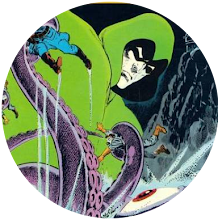Before getting down to the business of the day, I have to announce the results of our vital poll to discover whether you'd rather be drowned or be killed by giant scorpions. Needless to say, it was a hard-fought battle but, at last, the result is in - and that result is this:
5 (29%)
|
12 (70%)
|
So, there you have it. The vast majority of people on this planet want to be killed by giant scorpions. We can only hope the governments of the world oblige and immediately set about creating a race of such creatures with which to dispatch us in the way in which we've demanded.
But, until that happens, there are other things to contemplate.
And one of them is Timeslip.
During the late 1960s and early to mid 1970s, it seemed like ITV's children's drama department was obsessed with creating its own version of Dr Who.
Needless to say, despite numerous brave attempts, they never quite managed it, although The Tomorrow People was probably as close as they got.
But there were other attempts.
And one of those attempts was Timeslip in which two children find a time portal between the fence posts of an abandoned military base and thus go on to have a string of inadvertent adventures in both the past and future. Did any TV show ever have a more doom-laden or oppressive theme tune than Timeslip? It was like Beethoven himself had been brought in to do the job.
Like the fearless adventurer in Nostalgia that I am, I've recently and repeatedly plunged into the Time Stream to re-watch the show's first serial which is set in World War Two and features Germans capturing the then active military base in an attempt to gain its scientific secrets. Can our youthful heroes thwart them and save the war for Blighty?
The main thought that strikes me upon re-watching it is that the boy Simon is clearly a Reed Richards in the making, having a level of knowledge of cutting-edge science that I suspect few real children have.
Sadly, if he's Reed Richards, his companion Liz is clearly Sue Storm, being completely and totally useless at all times. There's not an escape attempt she can't scupper with her stupidity, cowardice, dithering, panicking, crying and incompetence.
I did remember the show as being tense, dark and dramatic. In fact, watching it now, it all seems rather light and innocent. Even the leader of the Nazis in the first serial is a mostly amiable pacifist who repeatedly refuses to commit acts of violence. In the meantime, it's also made clear to us that Liz and Simon can't be hurt while they're on their adventures. Even being shot in the stomach from a few feet away does Liz no harm at all, other than to set her off crying and panicking again. Knowing that no harm can befall the stars does somewhat rob the show of its promised dramatic tension.
Liz and Simon may be the central characters but the show's dominating presence is that of Denis Quilley's Traynor, a government scientist who clearly couldn't care less about the welfare of the people around him just as long as he gains scientific knowledge from the children's adventures. He's not evil as such, just completely emotionally disconnected from the fate of those around him. Thrown into this mix are Liz's mum and dad, the former of which has a psychic link to Liz that enables her to see the children's adventures and relate them to her husband and to Traynor. Call me a cynic but I get the feeling this element was added in order to help pad out the episodes and guarantee they came in at the right running time.
Speaking of which, it did depress me that numerous comments under the episodes are by people complaining about them being too slow-moving but, personally, I like it in TV shows and movies when nothing's happening and I tend to lose interest when things get exciting, so I disagree with those comments completely and sentence the people making them to sit through the extra extended director's cut of my favourite movie Let the Right One In. That'll show them what, "Slow-moving," means.
I'm currently two episodes into the second serial The Time of the Ice Box which is a very strange affair, featuring a female scientist straight out of the Hyacinth Bucket school of acting and John Barron basically acting exactly the same way he did when he played CJ in The Fall and Rise of Reginald Perrin. Such sitcom related acting is very strange in a dramatic sci-fi show but also oddly endearing and engaging.
A lucky break the show's had is that, although it was filmed in colour, it seems that 1970s ITV was as bad at preserving its heritage as the BBC and, nowadays, only black and white versions exist of most episodes. This might sound like a bad thing but monochrome does tend to add a certain gravitas to proceedings that colour inherently lacks.
The final quirk of the show worth mentioning is that each serial's introduced by famed TV science reporter Peter Fairley, there to explain the science behind it all and assure us that boffins are even now proving the depicted adventures are possible. To be honest, I'm not convinced he's right but it is quite amusing to see him make the attempt.
All in all, it's not a masterpiece but it is diverting and, with its twists, turns, revelations and developments, it is engagingly intriguing.
Anyway, those are my thoughts on the matter. If you have thoughts on it, you're free to share them in the comments box below. In the meantime, if you want a reminder of the show or have never seen it before, Episode One is posted above for your entertainment.
| "What is a Time Bubble? You can't see it, of course, but it might help you visualise it to think of a balloon. Supposing some little patch of information – some little patch of history – gets slowed down, and instead of flashing backwards and forwards it floats, gently, as if in a bubble. Supposing you could get into that bubble – that bubble of history – and travel with it. Then you could move forwards and backwards in time at will." — Peter Fairley. |








































































9 comments:
I remember watching this back in the day, and again when it was repeated in 1972 or '73. I now have the DVDs of the series and enjoyed the first adventure the best. I don't even mind it being in black and white 'cos that's how I first saw it. And isn't the guy who played Simon doing well these days? He's now co-presenting 'Pointless' with Alexander Armstrong. (And if you believe that, I've got a big tower in Paris that I'll let you have cheap.)
I've now seen the one episode that survives in colour and the show definitely benefits from being in black and white. It seems way too gaudy for its contents when seen in its original state.
Peter Fairley's career was arguably past its peak by 1970, after the first moon landing. In any case it jumped the shark when they had him on dressed as Batman.
Is that true, Joe? Whatever were they thinking of?
Steve, I thought Let the Right One In was a fantastic movie as well. I prefer the original, Swedish version, although the English language remake wasn't terrible, and worth watching.
Both made me remember the swimming classes I had to take when I was a kid.
I think it's pretty hard to make a really great horror movie, but they did it there.
Great horror movies are always about something more than just horror.
M.P.
I've seen about twenty minutes of the remake. It seemed OK but I'm afraid that it was so similar to the original that I couldn't see any reason for it to exist and lost interest in it.
Yes, Peter Fairley did indeed appear on a TV news programme dressed as Batman. It was one of those childhood moments when you feel truly embarrassed by an adult.
I saw the series on its first transmission, and it was one of my favourite at the time. I was 9 so the two teenage leads seemed quite old to me. I preferred the later adventures that were set in the future. Look-In included a comic strip version that was printed in colour.
Clive, I too preferred the more futuristic episodes, especially The Year of the Burn Up.
Post a Comment